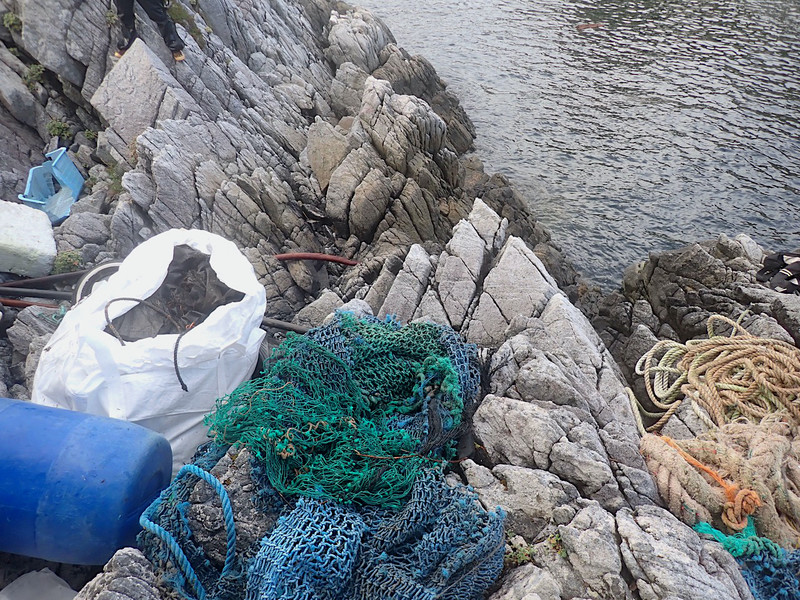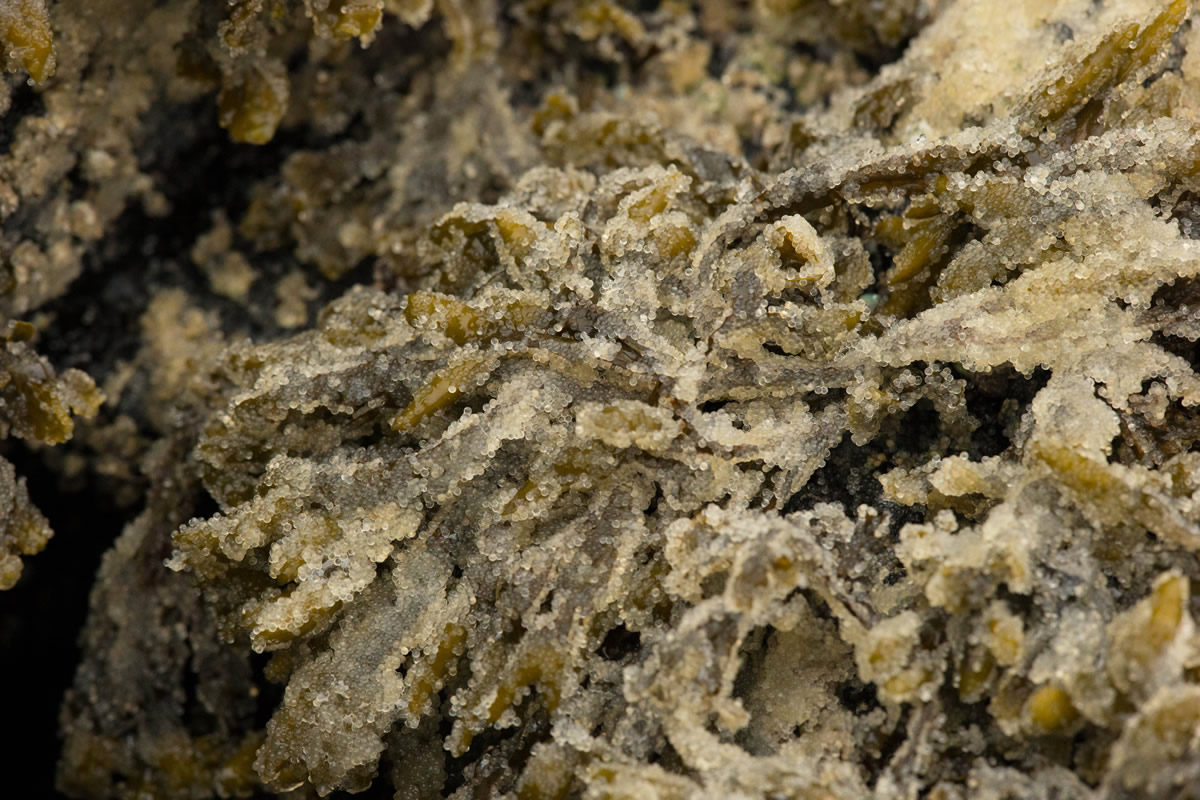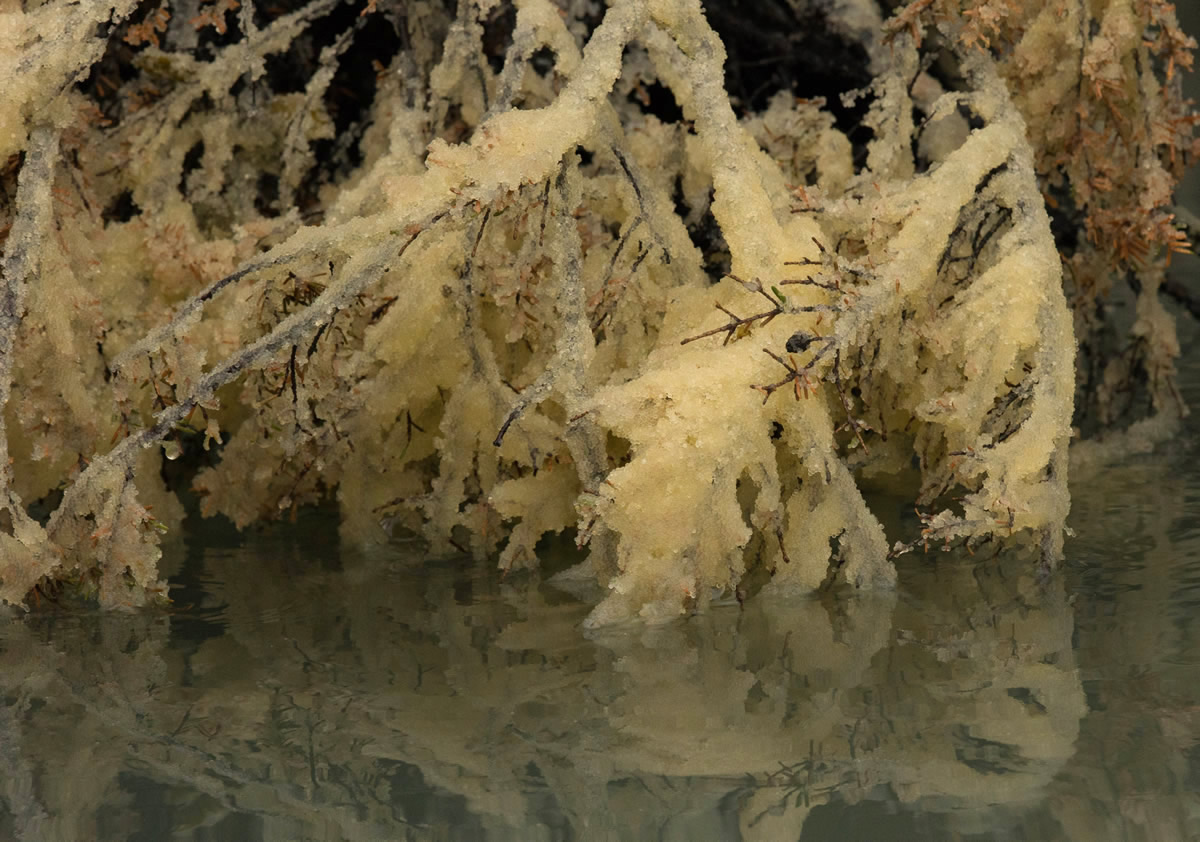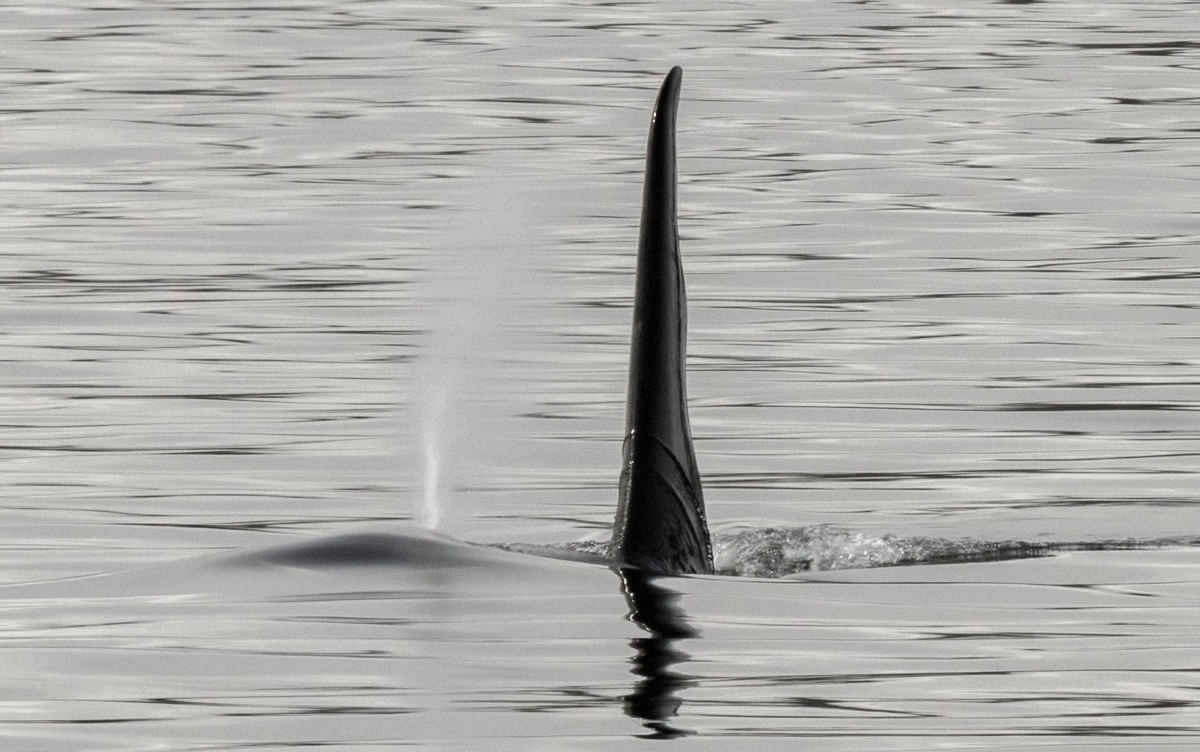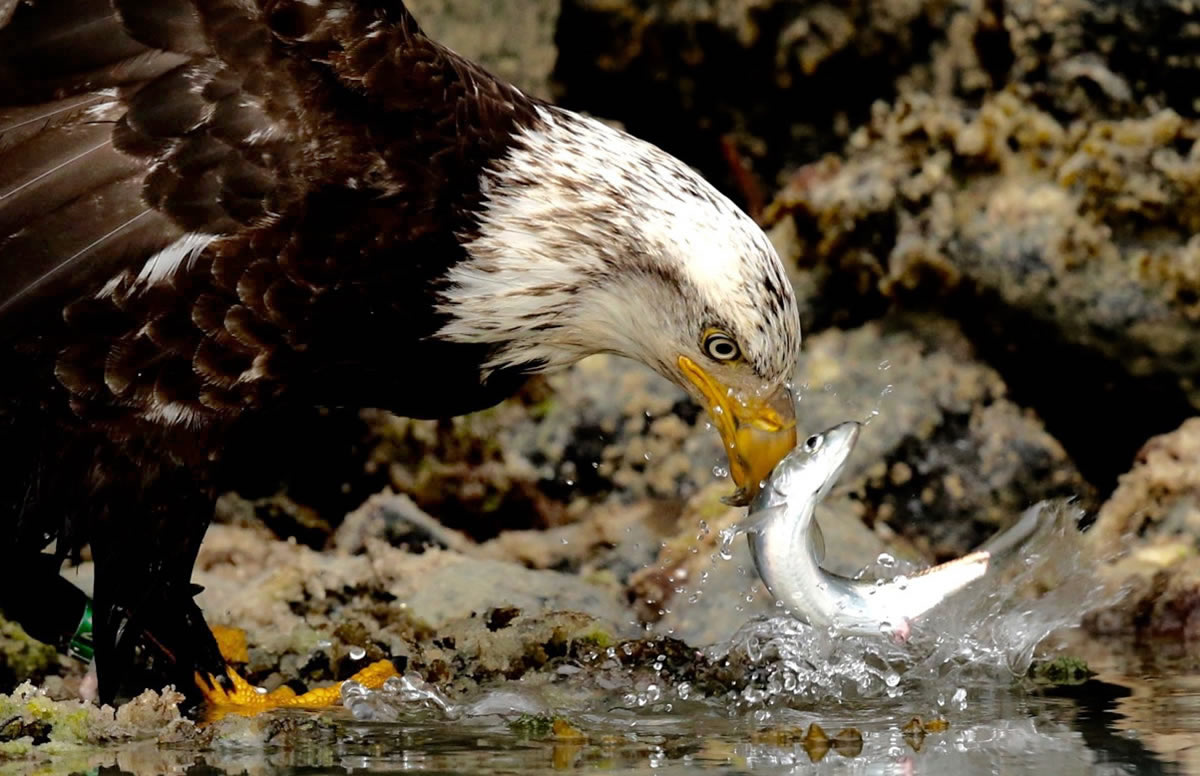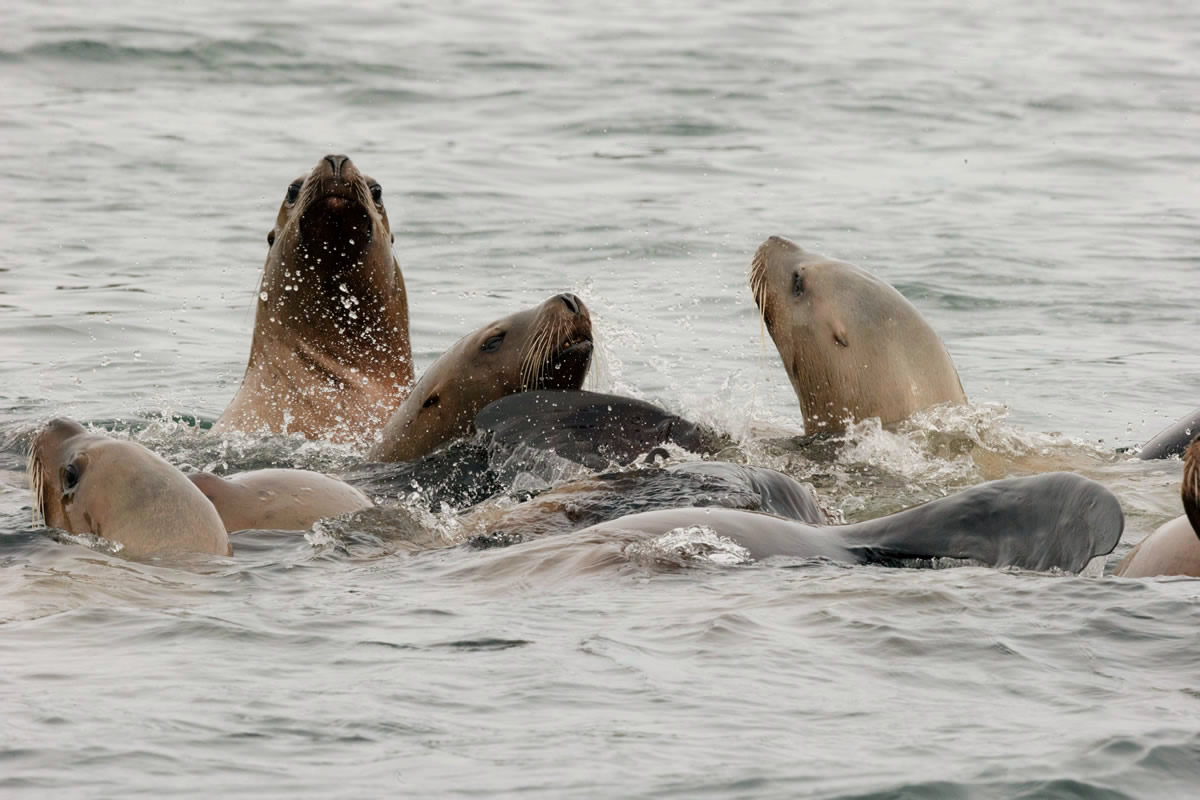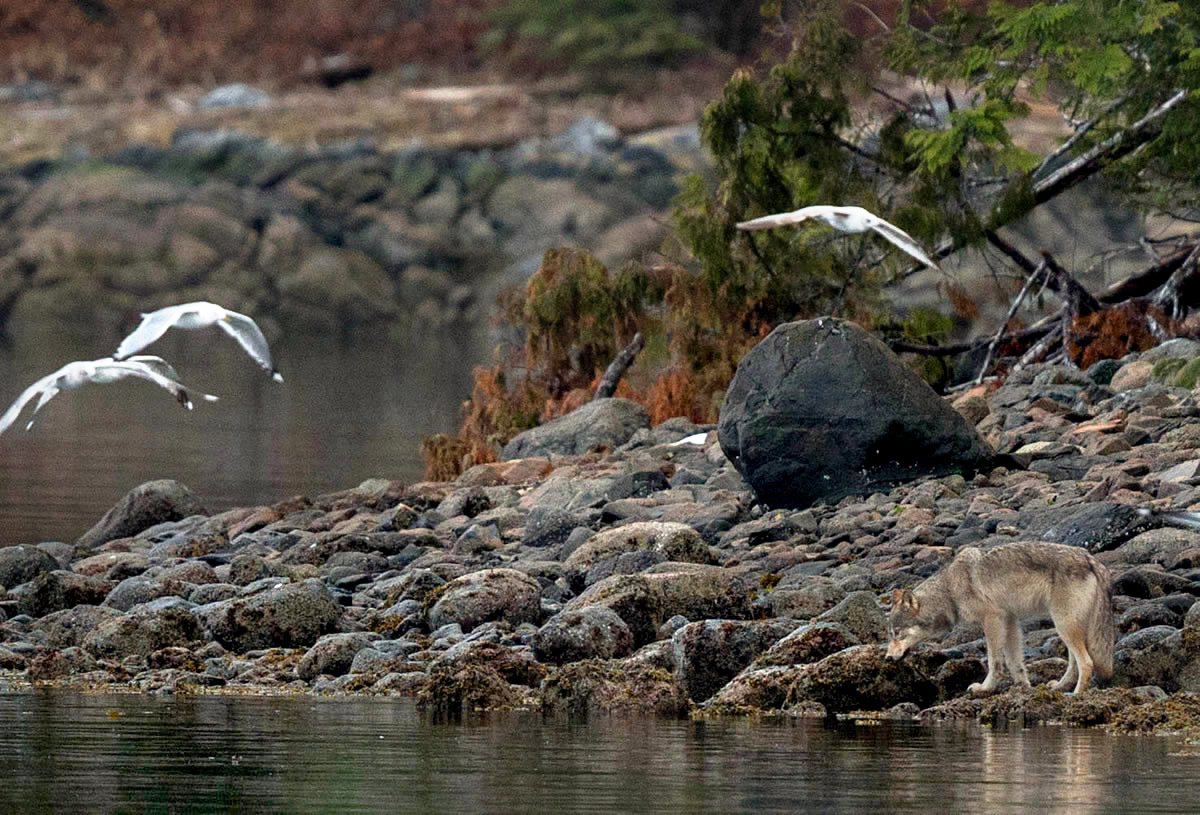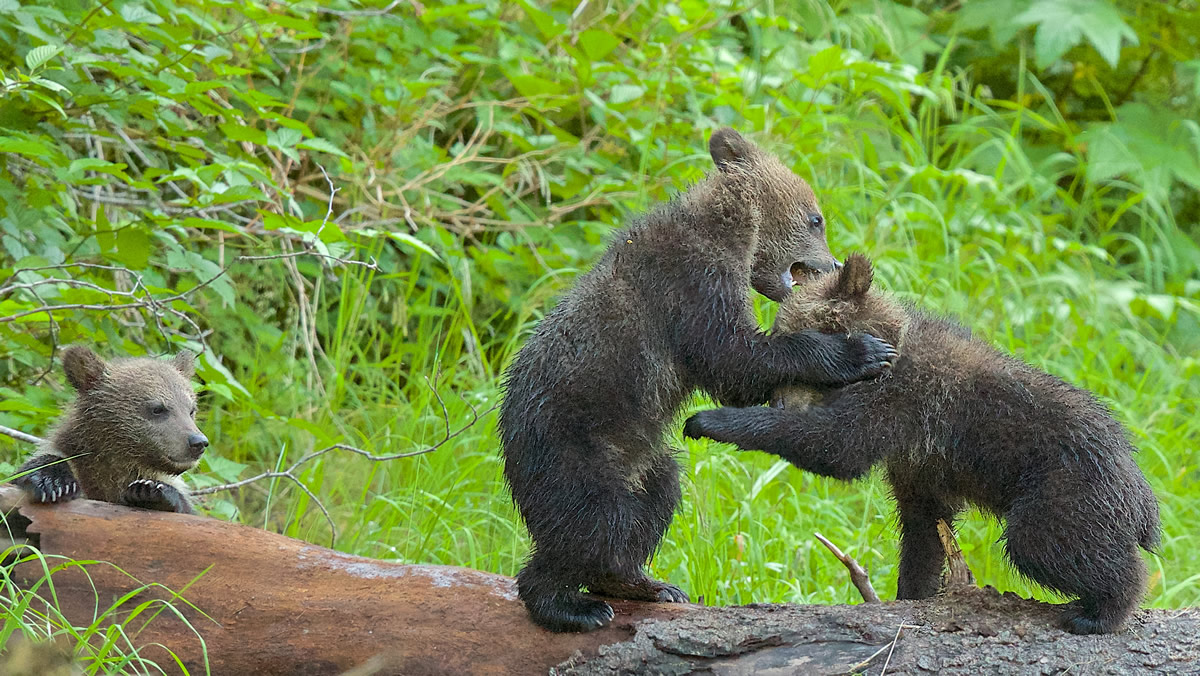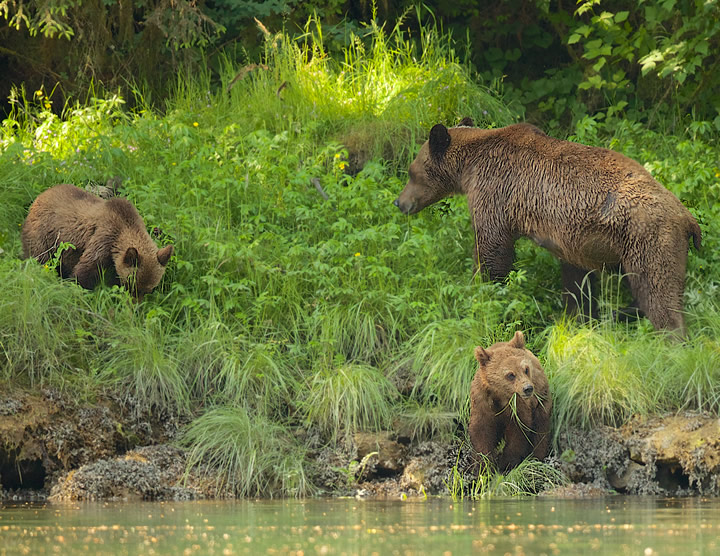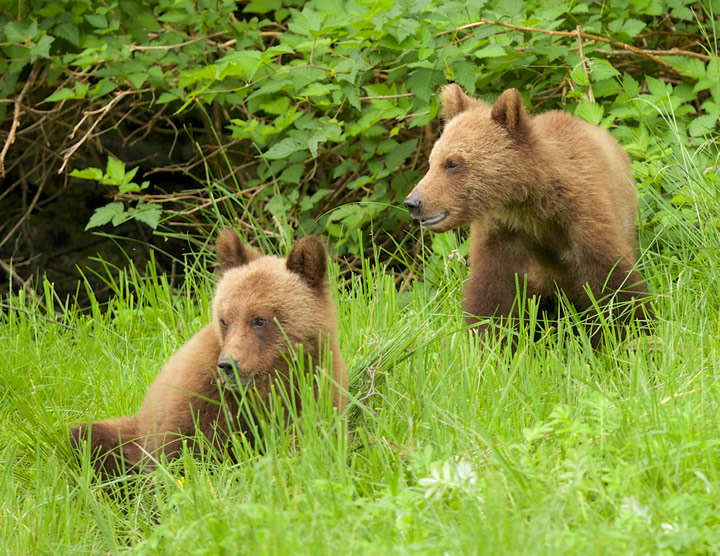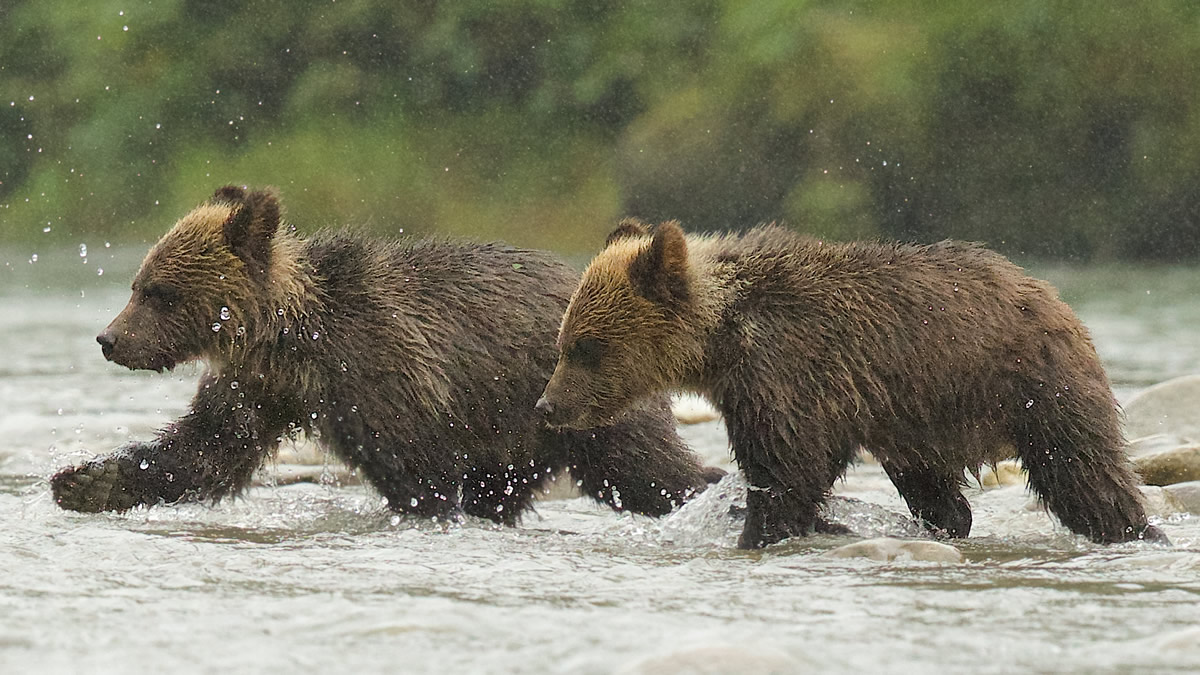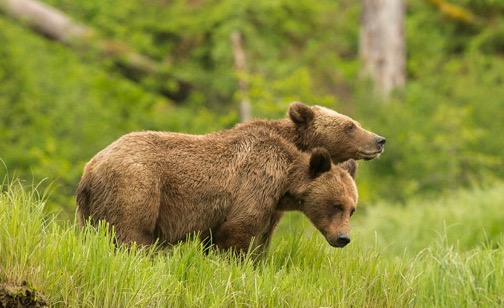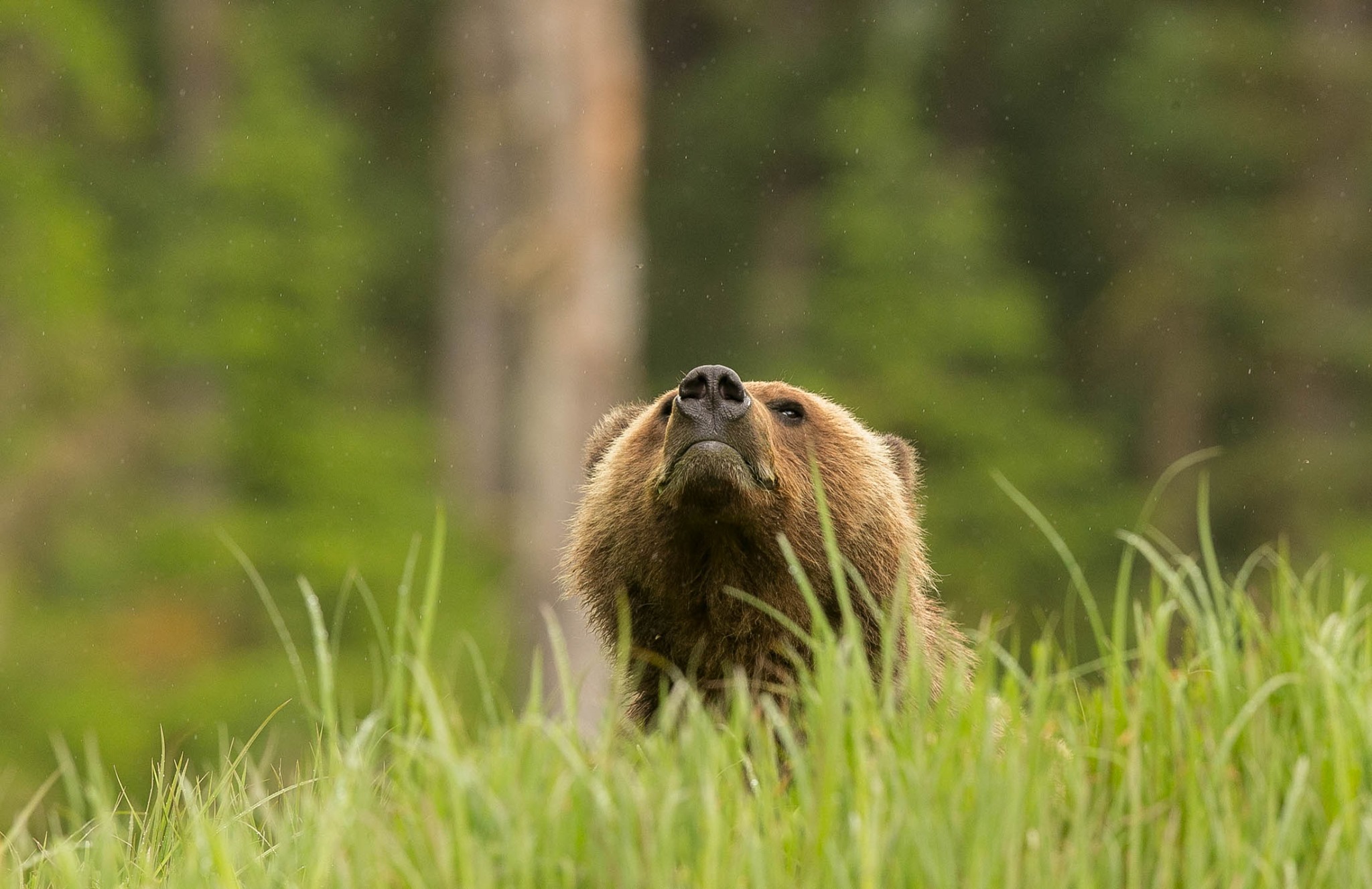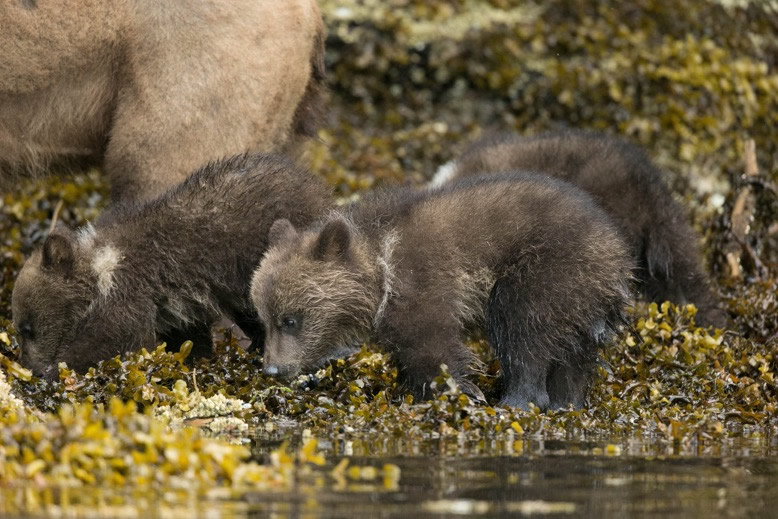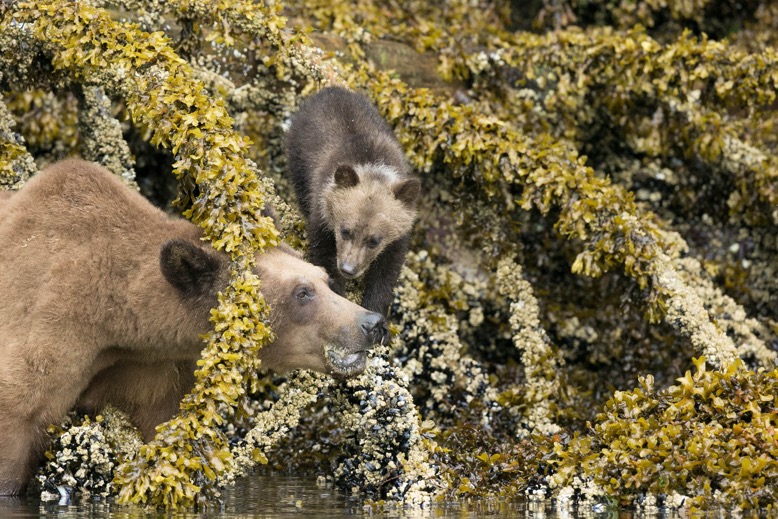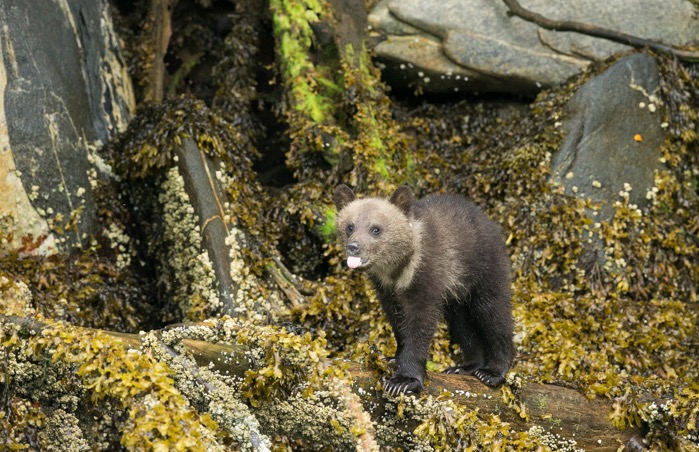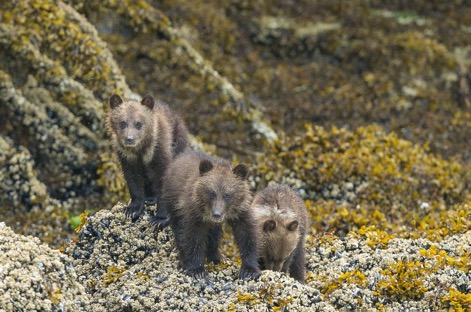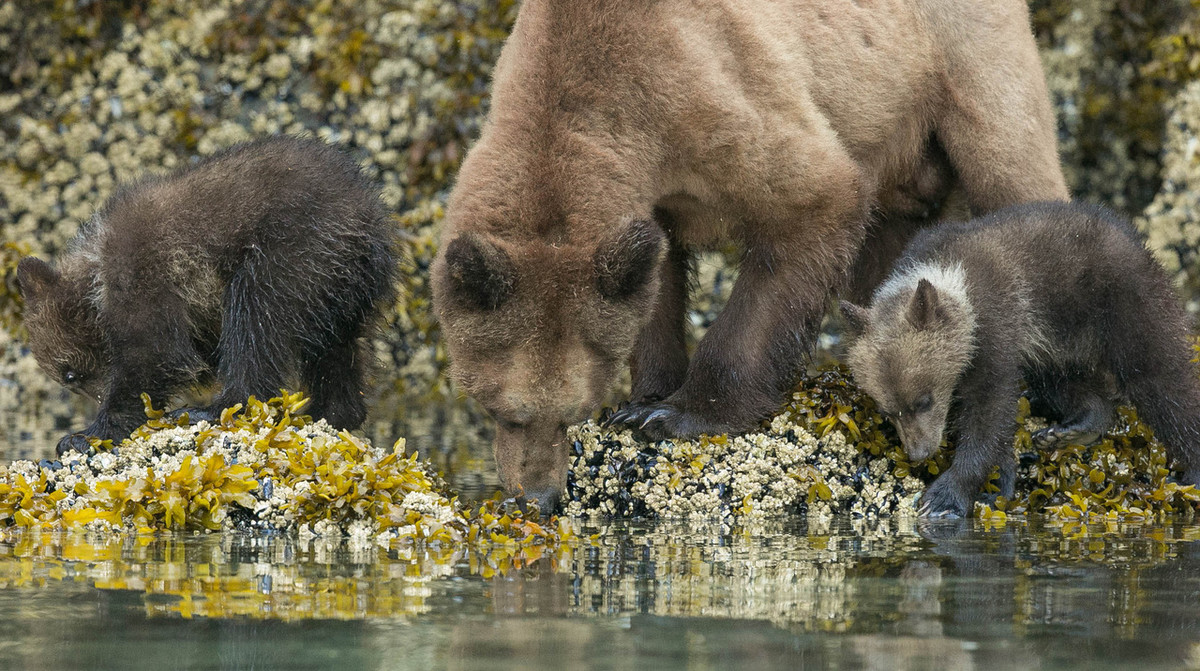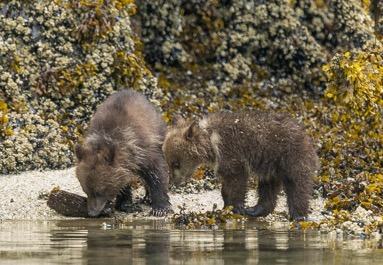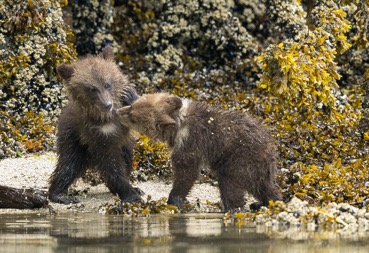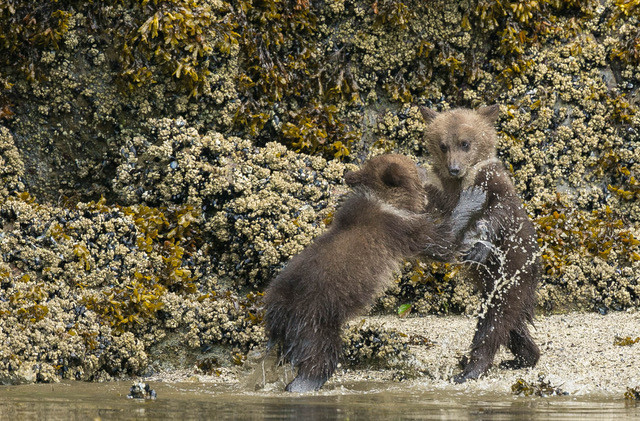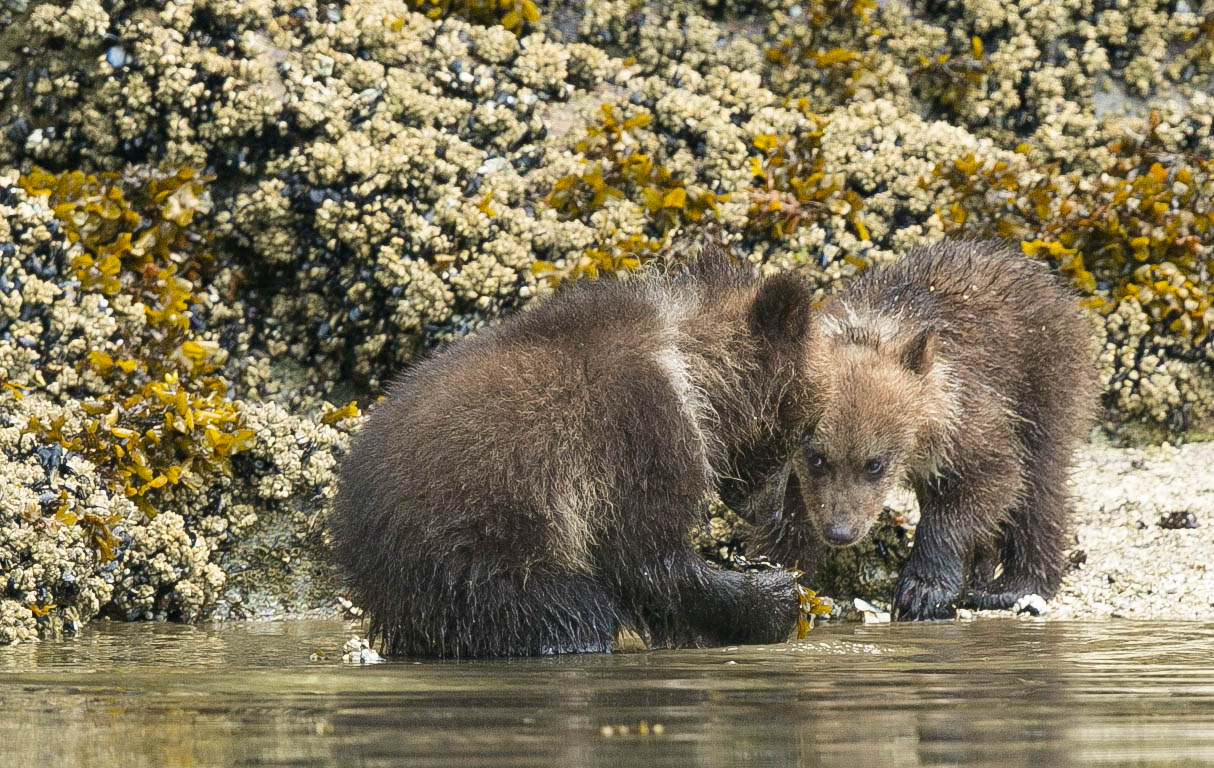|
|
|
 |
 |
 |
|||
Official Blog of the Great Bear IIFirst class wilderness adventures and holiday cruises on the coast of British Columbia.Current | 2022 | 2021 | 2020 |2019 | 2018-2016 | 2015 | 2013 | 2012 | 2011 | 2010 | 2009 | 2008 | 2007 | 2006-2004 Wednesday, December 16, 2020Moments in Nature that Inspire Us... 
Wisps of mist hang in the towering, moss- draped trees of the Great Bear Rainforest that rim this river estuary. Eagles with outstretched wings perch on old snags, revelling in the warmth of the sun that is just beginning to peer over the mountain- tops. The sweet smell of mother earth wraps around us like a well- loved blanket and the symphony of songbirds floats from the forest beside us. 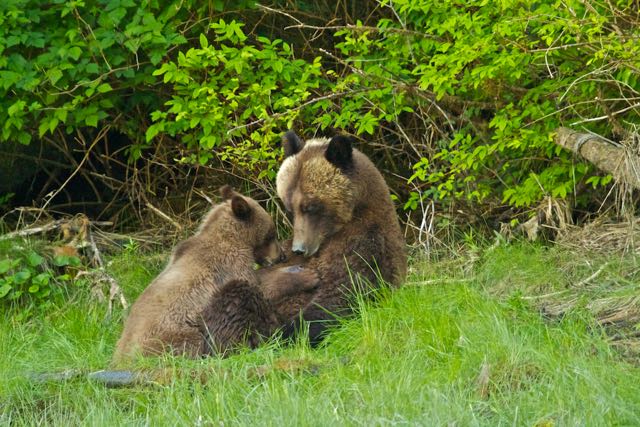 Floating in our 18 ft zodiac we are all mesmerized by the reflections in the perfect calm of the tidal channel... beauty found in such simplicity... patterns where the forest meets the water... a mother merganser and babies dwarfed by sedge grass.. and the thunder of a nearby waterfall as it tumbles out of the rainforest.
As we peer into the shade of the forest floor we often feel like eyes are watching us but on this morning we see those exquisite eyes staring back at us!
"Eyes are windows to the soul" comes to mind as she follows us with her amber eyes. As our zodiac comes to rest in the sedge grass across the channel from her, she lazily gets up and changes positions still bewitching us with her eyes. Finally, she rises, stretches and makes her way down the bank to the grassy estuary, followed by her yearling cub!
Floating in our 18 ft zodiac we are all mesmerized by the reflections in the perfect calm of the tidal channel... beauty found in such simplicity... patterns where the forest meets the water... a mother merganser and babies dwarfed by sedge grass.. and the thunder of a nearby waterfall as it tumbles out of the rainforest.
As we peer into the shade of the forest floor we often feel like eyes are watching us but on this morning we see those exquisite eyes staring back at us!
"Eyes are windows to the soul" comes to mind as she follows us with her amber eyes. As our zodiac comes to rest in the sedge grass across the channel from her, she lazily gets up and changes positions still bewitching us with her eyes. Finally, she rises, stretches and makes her way down the bank to the grassy estuary, followed by her yearling cub!
 How can anyone ever completely explain what we feel when a mother Grizzly sits on the grass in front of us, just feet away, closes her eyes and hums, while her cub noisily nurses? Or how it makes you laugh out loud when the cub sits like a human being in the grass, paws folded neatly on his tummy and stares intently at us?
How can anyone ever completely explain what we feel when a mother Grizzly sits on the grass in front of us, just feet away, closes her eyes and hums, while her cub noisily nurses? Or how it makes you laugh out loud when the cub sits like a human being in the grass, paws folded neatly on his tummy and stares intently at us?
The gifts of these images, sounds, and smells from this inlet in Kitasoo Xai'xais Territory play in our head all winter long... inspiring us to help look after wildlife and their wild homes. While we are talking with government about why trophy hunters cannot be allowed to determine the future of wildlife and why it's so important for all of us to understand that we are not separate and superior to nature, but a part of it, we can still feel the mother Grizzly's gaze from her moss covered pillow in the Great Bear Rainforest. We hope that everyone has been finding nature inspiring and healing during these challenging times.
Trish, Eric and the whole team at Ocean Adventures.
Sunday, October 11, 2020NEW UPDATE: THE MARINE DEBRIS REMOVAL INITIATIVE: GIVING BACK TO THE COAST DURING COVID-19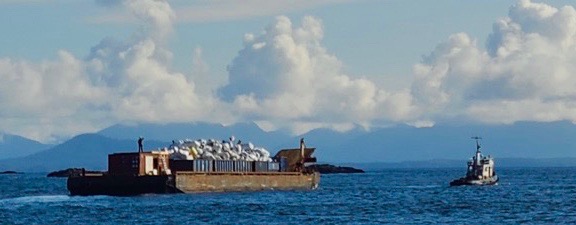
Photo credit Eddy Savage Photography Our relationship with the Heiltsuk Nation of Bella Bella is not only mutually beneficial, but crucial to the experience our guests have in their territory, to the success of Ocean Adventures and has been key to the success of the Marine Debris Removal Initiative. We are grateful for and humbled by their guidance and involvement from the inception of this epic project and for the great communication, professionalism and hard work by everyone in the Heiltsuk Integrated Resource Management Department, the Heiltsuk Nation, and Heiltsuk Horizon.MORE ABOUT HEILTSUK HORIZON... Heiltstuk Horizon provided the tug, the barge and crew, some of whom are from the Heiltsuk Nation from Bella Bella, for the Marine Debris Removal Initiative. "Heiltsuk Horizon Maritime Services Limited is a partnership that brings together the millennia-old stewardship and seafaring heritage of the Heiltsuk Nation with the offshore and marine industry expertise of Horizon Maritime." Through our shared values and commitment to protecting the marine environment, we are demonstrating how industry and First Nation communities can work effectively together." (https://heiltsukhorizon.ca) After the poorly orchestrated and supplied response by the Canadian and BC governments when the Nathan E. Stewart ran aground in Heiltsuk Territory in 2016, spilling more than 110,000 litres of diesel and other contaminants, the Heiltsuk knew that they needed their own Indigenous Marine Response, from which the partnership that formed Heiltsuk Horizon, was created. This partnership between the Heiltsuk and Marine Horizon is ground breaking, helping supply not only the equipment needed for prevention, response and clean up, but the necessary training for Heiltsuk mariners to become Transport Canada certified. All of us at Ocean Adventures including Captain Eric Boyum and crew members on board our MV Great Bear II for this Marine Debris Removal Initiative, were very honoured to be working with Heiltsuk Horizon during this complicated project. and on shore to and in the office We are grateful for the support, shared knowledge, and communication from the Heiltsuk Integrated Resource Management Department and the Heiltsuk Nation for their approval of this project and for their guidance and involvement from the very beginning. "The respectful protocol agreement that Heiltsuk have with Ocean Adventures and members of the SSTOABC, is foundational to our successes", says William Housty, Heiltsuk Integrated Resource Management Department Chair. Ǧiáxsix̌a to the HIRMD, the Heiltsuk Nation and Heiltsuk Horizon. 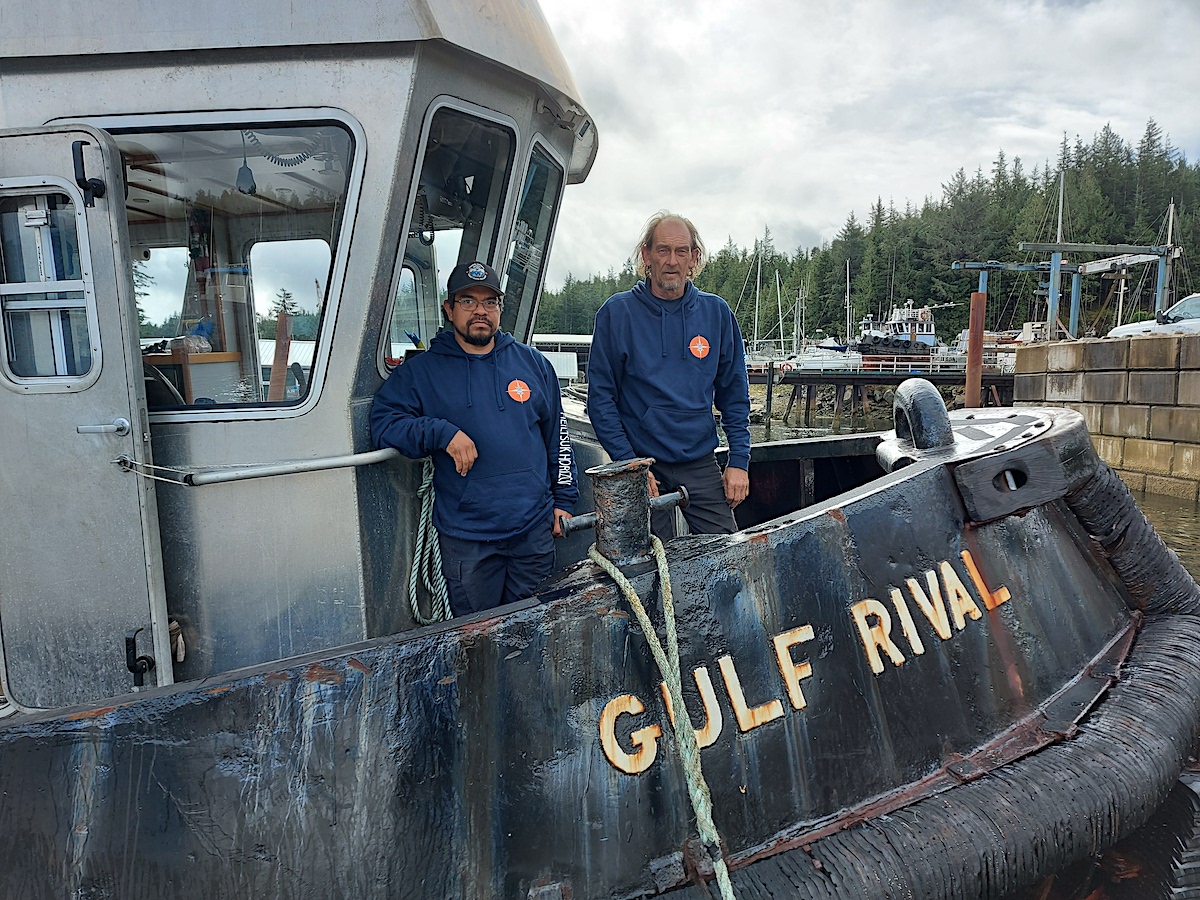
Photo credit Rusty Snow, Heiltsuk Horizon MORE TO COMEStay tuned in the weeks ahead to learn more about other businesses that worked together on this important project and the communities and Nations that were instrumental to the success of this Marine Debris Removal Project. Sunday, October 4, 2020
NEW UPDATE: THE MARINE DEBRIS REMOVAL INITIATIVE: GIVING BACK TO THE COAST DURING COVID-19
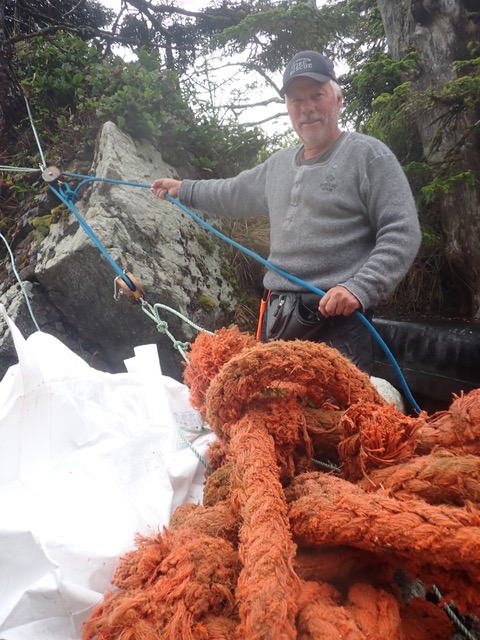 One of my greatest satisfactions from our work in the Marine Debris Removal Initiative is when we can take abandoned and lost fishing nets out of the marine environment. We have found sections of gill nets, dragger nets, and even the monofilament high seas drift nets, fouling these shorelines along the central coast of British Columbia. These nets are often buried under sand and rock, or wound around large piles of logs that are washed up on the beach, or hanging precariously on rocky outcroppings.
One of my greatest satisfactions from our work in the Marine Debris Removal Initiative is when we can take abandoned and lost fishing nets out of the marine environment. We have found sections of gill nets, dragger nets, and even the monofilament high seas drift nets, fouling these shorelines along the central coast of British Columbia. These nets are often buried under sand and rock, or wound around large piles of logs that are washed up on the beach, or hanging precariously on rocky outcroppings.
Far too many times throughout my years working on the BC coast I have come across marine mammals and birds tangled in netting. It is always emotionally difficult to witness the needless loss of life of an innocent animal. Occasionally, we have been able to free trapped mammals from the netting, thus avoiding a certain slow, and painful death. Sometimes it has not been possible, and we can only report the trapped animal to the Marine Mammal Incident Reporting Hotline and they may or may not be able to help. Every year we have whales becoming entangled in fishing gear and fish farm anchoring lines. The saving of a trapped whale or dolphin is definitely left up to those who have been trained in this skill. We as humans, who share this beautiful marine environment with all those who call it home, must end the carnage caused by our use of the marine environment, for resources and for pleasure. 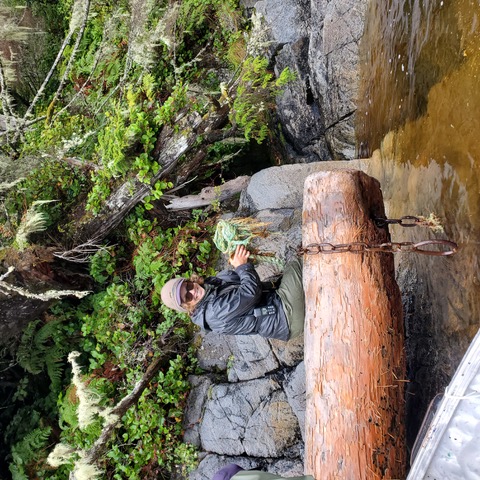 FROM KRISTA GOODERHAM
FROM KRISTA GOODERHAM
I have been thinking a lot about the tenacity and resiliency of life. All throughout the COVID crisis, life has become hard for many people that may have never had to deal with such hardship, and even harder for those that already lead incredibly challenging lives. But Robert Frost once said, "the one thing I've learned about life: it goes on". It is not to be callous about any of the struggle. It is instead to understand that even in the harshest of climates and the hardest of times, life can prevail. Over the past weeks I have clambered over slimy wet logs, teetering on the edge of rot. I have crawled through the maze of salal and dug in to the mossy layers of soil. On every venture into the woods I have found garbage; foam, plastic, rope. However, I have also found life growing in the most unlikely of habitats. Here are 3 examples of the tenacity of life to survive on any substrate. Salal growing in a mound of plastic wrap that I dug out between the dirt in a log jam, grass growing into a 3m piece of foam, and finally a Sitka spruce tree growing out of a foam float. Every animal leaves a trace of their being. The people that lived here long before settlers arrived left clam and mussel shells creating large layers called Midden's, still found in the soil layers near habitation sites. These shells will breakdown and return much needed calcium and other nutrients back in to the environment to be utilized by plants and trees. In places where shell middens have been found, old growth cedars have been found larger and healthier (www.hakaimagazine.com/news/how-british-columbias-coastal-people-fertilized-forest/). Midden is a Scandinavian word meaning rubbish heap and is now used by archaeologists to describe features containing domestic waste. These are key features that remind us how people use to live and utilize the land in these areas. What has been the most difficult part of this project for me to process is that when I reach in to the soil layer, I pull out layers upon layers of foam plastics, sometimes as far as my arm can reach. These will be the reminders and remainders that show the future archaeologists how we lived and used/abused the land. Our trash will out live us, plastic does not biodegrade (look up how long plastics last at sea or lifespan of plastics). But what lightens my heart, is that even long after we are gone, life like I find in the salal and the spruce, will still survive and grow because that is just simply what it does. 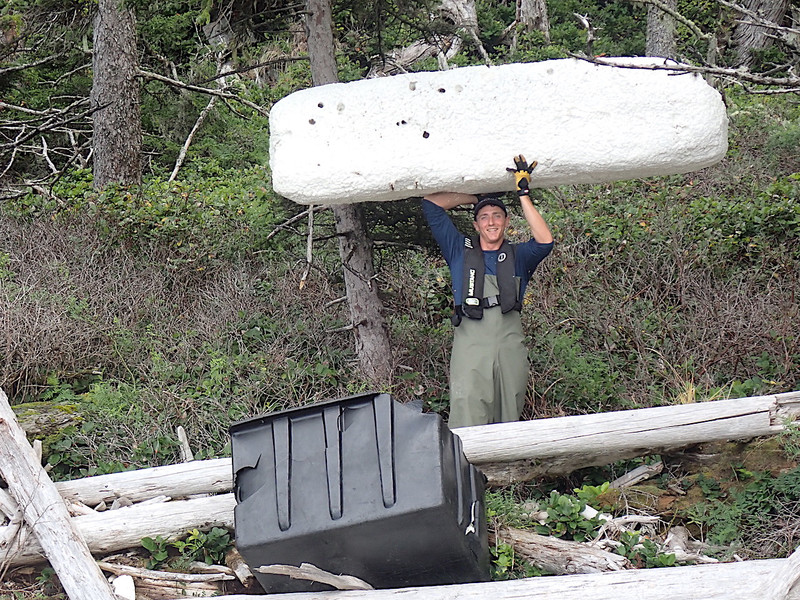
FROM ADAM PURKIS The biggest thing I've taken away from the past weeks of being a part of this project has been the immense sense of pride and accomplishment in knowing that we are taking part in something that is much bigger than ourselves. Assisting in the helicopter operations and seeing the massive lifts we put so much effort into building being taken away, was a truly visceral experience. The work we've been doing has been gratifying in itself but the sense of satisfaction in seeing all that debris fly away is difficult to put into words! I'm truly grateful to be a part of this project and am excited to see what more we can accomplish. Also, I was super excited to find a glass ball on one of our last days of cleanup on the first expedition! I found it in the most unlikely of places, nestled two feet deep in a precarious pile of logs high up in a nasty log jam. I was incredulous that something so fragile could have survived in such a place!
MORE TO COME

Tuesday, September 22, 2020
THE MARINE DEBRIS REMOVAL INITIATIVE: GIVING BACK TO THE COAST DURING COVID-19
Saturday, February 1, 2020
GREAT BEAR RAINFOREST PACIFIC HERRING SPAWN: ONE OF NATURE'S GREATEST EVENTS... 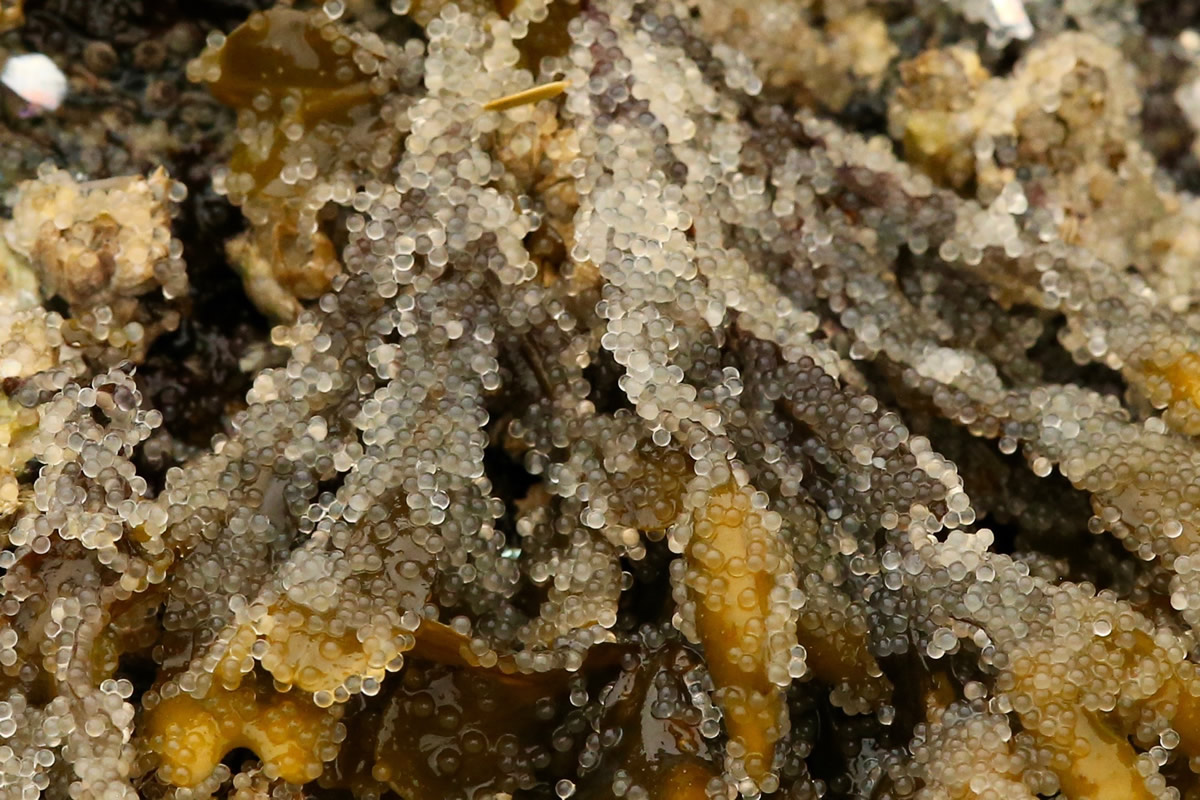
Normally a vibrant yellow, the rock weed in these photos were blanketed in the eggs of Herring, deposited in just a few hours! Each year in early spring, tens of thousands of tons of Pacific Herring migrate from offshore to near-shore habitats to spawn en masse in one of nature's most spectacular events. The waters along shorelines flow chalky white with herring milt and eggs. The spawning herring and their eggs attract both marine and terrestrial predators - at a time when food sources tend to be low.Branches from trees that have been immersed in the sea during high tides... now they are covered in Herring eggs. Coastal First Nations have for millennia, put trees branches and seaweed fronds in the water for the Herring to lay eggs on as their methods of harvesting. Other than the wild Pacific salmon, few species in B.C. are as ecologically, culturally or economically important as the Pacific herring. They are a keystone or foundation species of the marine and terrestrial food web, directly supporting salmon, halibut, seals, sea lions, and whales, and many species of seabirds. At low tide, the table is set for terrestrial animals such as eagles, wolves and bears who come to the beaches to feast on the Herring spawn that has attached to rocks, seaweed, and branches.The Pacific Herring have also fed coastal First Nations for thousands of years. The traditional First Nations spawn on kelp (SOK) fishery involves the suspension of tree branches, kelp fronds and other seaweeds in sheltered areas where herring spawn prodigiously in early spring. The roe builds up in multiple layers until harvesters collect it, and the adult fish are left to spawn again in the future. Seabirds, Eagles, Sea Lions, Whales, Wolves, and other territorial and marine animals come to feast on the Herring and Herring row. In 2018, the Heiltsuk People of Bella Bella ended the industrial seine and gill net fisheries in their territory as have the neighbouring Kitasoo/Xai'xais People of Klemtu. It is in the territories of the Heiltsuk People of Bella Bella and the Kitasoo/Xai'xais People of Klemtu, that our early Spring 2019 trip took place. In the weeks that we spent with these tiny Pacific Herring, "seeing it is believing it" took on renewed meaning. 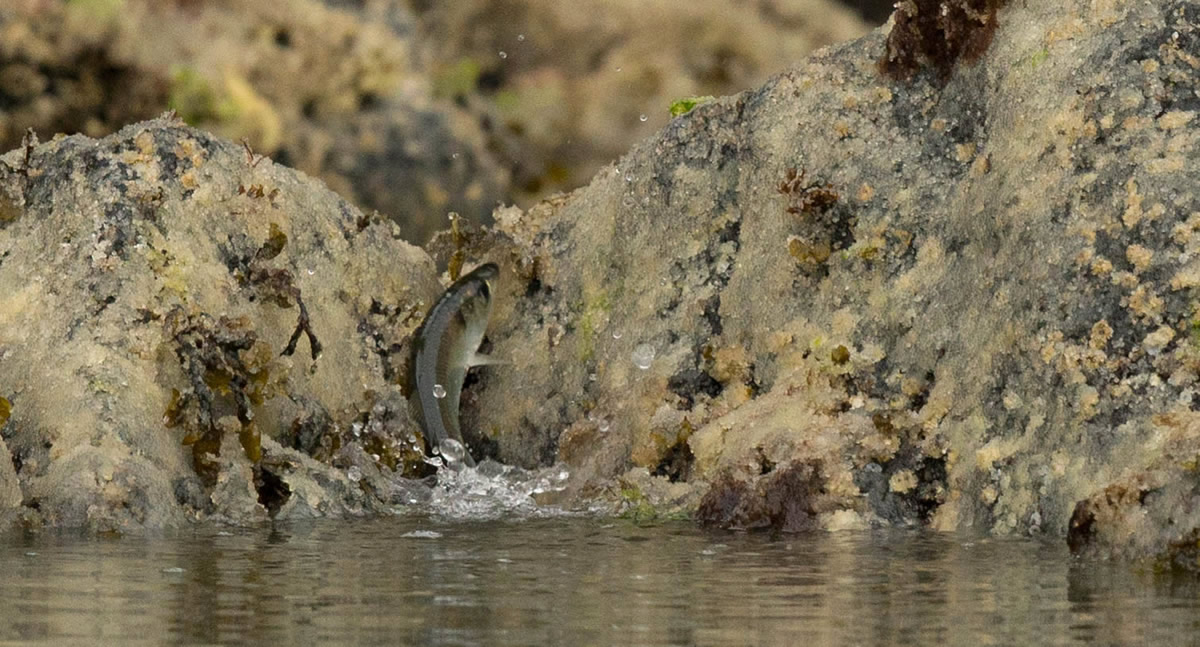
A tiny Pacific Herring female struggling to lay her eggs on the rocks. As we watched a tiny female Herring, struggling, literally half-in and half-out of the water, to lay her eggs, the profound meaning of her importance to the web of life on earth, became very clear.Tears streamed down my face as I realized the enormity of what we were witnessing. 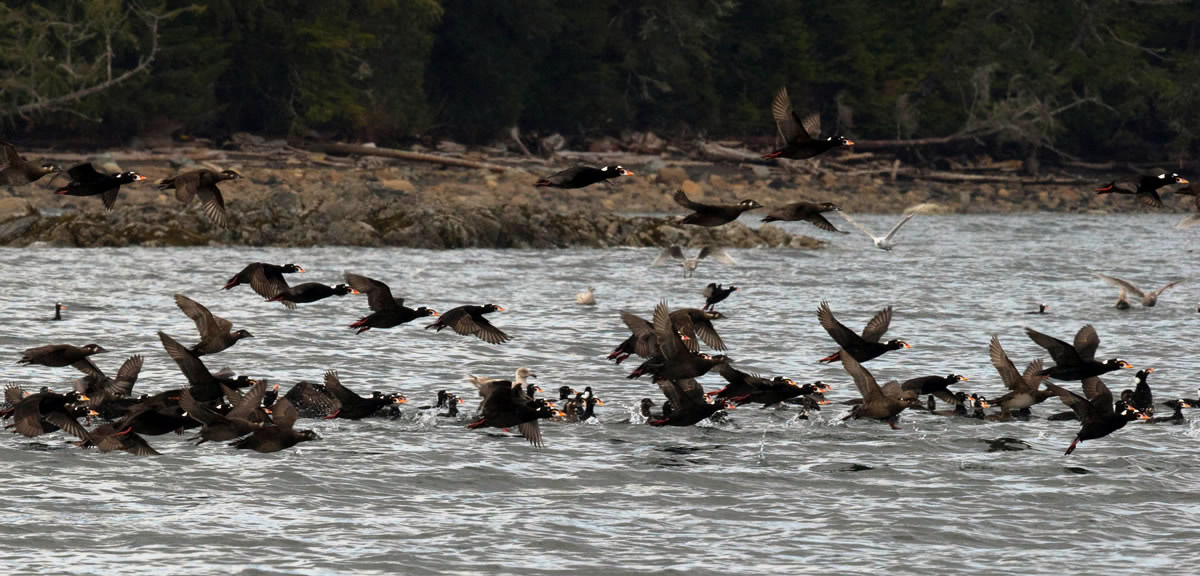
HUGE flock of Surf Scoters which we have seen in the thousands! I'm convince that if every person could realize what we did during these two weeks, there would be a lot more effort to ensure the survival of the Pacific Herring!We will offer these soul-stirring trips again in the early Spring of 2021, for which we are already taking reservations. Contact us to book on Herring trips in 2021.
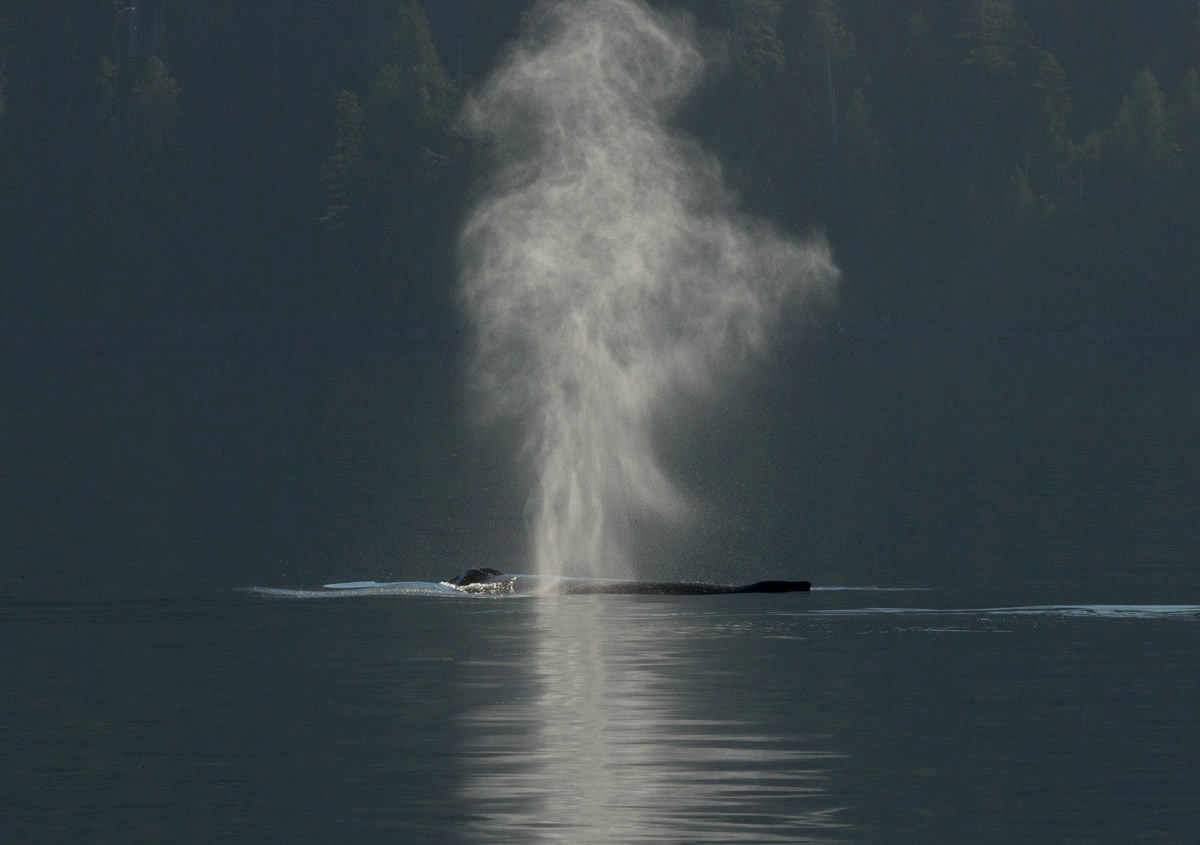
Sunday, January 12, 2020
ENSURING A FUTURE FOR A FAMILY OF BEARS IN THE GREAT BEAR RAINFOREST... A little less than 20 years ago, we met this MAMA BEAR for the first time, after she had been weaned from her own mother and was all on her own as a 4 year old. ALOT has changed in 20 years!We dedicate this story to Mama Bear whom many of our guests have enjoyed and photographed, along with the beautiful, spirited cubs, all of which seem to have quite the sense of humour! While we did see Mama with her first set of cubs, she had sadly lost both of them by that fall. It's a tough job being a mama grizzly, especially in her early days with so little experience. The following year she came out of hibernation with two more beautiful cubs. It was definitely the beginning of a long relationship with Mama Bear and her subsequent litters of cubs. The following series of photos are from our time with her and her second set of cubs, the first of her litters to survive... Sadly, the smallest of these two cubs did not survive to that fall, but, the larger of the two (who we named Fuzzy), thrived, and with Mama and Fuzzy teaching us SO much about the true nature of Grizzly Bear mamas and their cubs! The following series of photos are of Mama Bear and Fuzzy during the 3 years before he was weaned... As it is not typical for a male cub (and Fuzzy was a male), to stay in their mother's home territory, Fuzzy moved to another inlet where we've been fortunate enough to see him continue to grow and where we've recently seen him "wooing" the ladies: 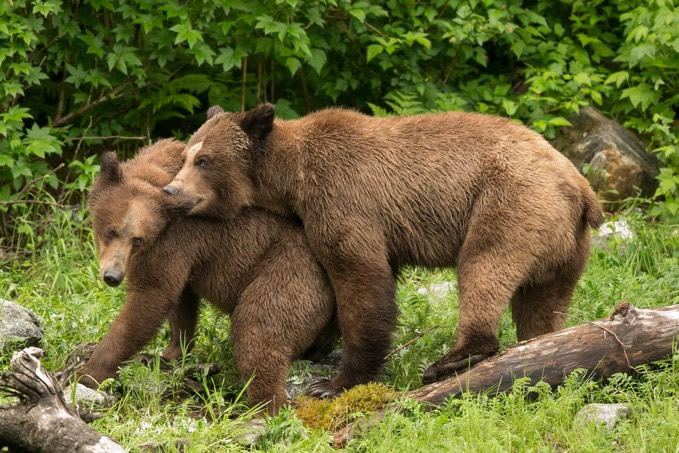
Back in Mama Bear's home territory, she had mated again after Fuzzy was weaned and the following spring, she came out of hibernation with 3 beautiful new cubs. Sadly, she lost 1 of the 3 cubs in their first year. The following series of photos are of Mama and these cubs, including the 2 that survived (that we call Girl Bear and Boy Bear. (Not very imaginative names, right?) When Mama's Girl Bear and Boy Bear were weaned, they spent at least the first year together and we've seen them together, on and off over the years since.. It is possible that Girl Bear mated in the spring of 2019, so stay tuned for updates. Could be a sad time for Boy Bear as it's unlikely that she would allow him near her cubs. Meanwhile, in 2018, Mama Bear had another set of 3 cubs. In true Mama Bear fashion, she presented her cubs to us one morning, the memory of which, still brings tears of gratitude to my eyes. Mama had literally been chased (by people from a anchored yacht), out of a safe haven that she likes to use for her new cubs, over a rock bluff, to a nearby tiny bay, where we found them feasting on berries in a bush at the edge of the rainforest. The cubs were climbing through the bush while Mama sat, human like, on a huge rock, very gently picking berries and eating them. (Her cubs still had a lot to learn in that respect.) As we slowly motored by, not wanting to disturb her and the cubs, she turned to look at us and then immediately got down off the rock, said something in mother bear language to the cubs.. before walking straight to the beach, closest to us. We do not take this kind of trust lightly, so we kept a close eye on Mama and the cubs for any sign of stress, which I'm happy to report, we never saw. The following are a series of photos from that morning as Mama taught her tiny cubs to forage for and eat barnacles.. After they'd learned from Mama how to eat barnacles, two of them began playing and fighting over a stick.. not unlike two human children fighting over a toy. Make sure you check out the facial expressions! While Mama Bear... and all of her cubs.. have had infinite patience with humans that behave respectfully, she was tested that spring, by people on private yachts, trying to get too close to her and the cubs and by people who were allowing their dogs to run wild in areas of her territory where she typically likes to reside when she's had new cubs. Fortunately, she shares her territory with the Kitasoo Xai'xais People of Klemtu who in partnership with BC Parks, are developing a new management plan for this area. And the news gets even better... In this very remote inlet where Mama Bear lives and has raised all of her cubs, there will be an outpost cabin built for the Kitasoo Xai'xais Coastal Guardian Watchmen to stay at and watch over bears like Mama Bear, Girl Bear, Boy Bear, and her latest 3 cubs and this spectacular, biodiverse inlet with its critical habitat for Grizzly Bears, spawning salmon, the red listed Marbled Murrelet and a host of other terrestrial and marine plants and animals. We are inviting all of you who have traveled here with us, who have spent time with Mama Bear and her cubs, to help the Kitasoo Xai'xais People build this cabin to ensure the future of these bears and their critical habitat. 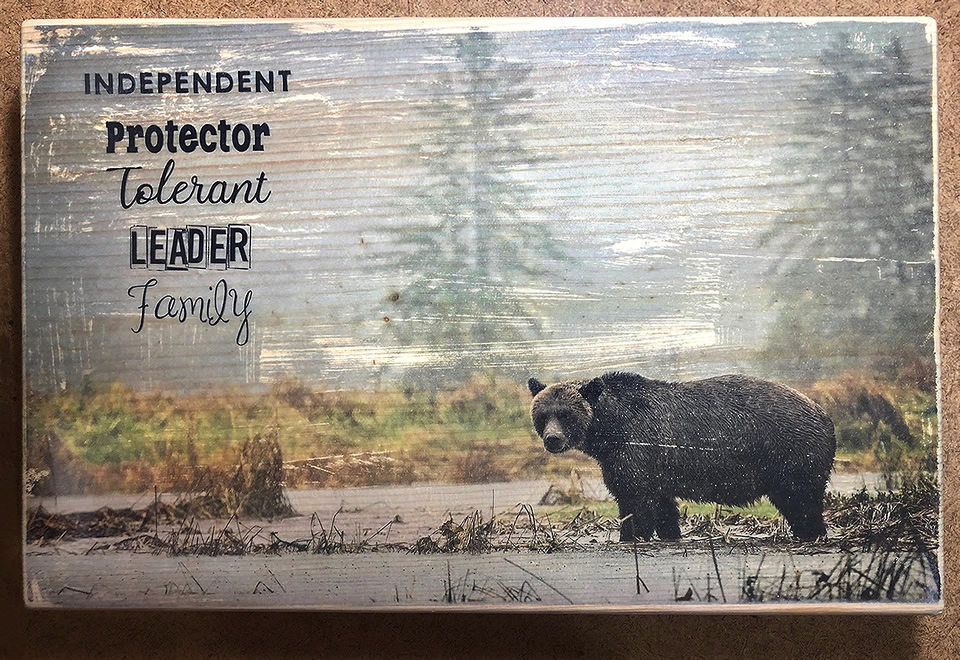
If this has inspired you, please email trish@oceanadventures.bc.ca for more information and how you can help with this incredible opportunity to be a part of ensuring a future for a family of bears in the Great Bear Rainforest. Additionally, our Chef Cindy, also an amazing photographer, is offering the following photograph (transferred onto wood) of Mama Bear for $65, of which she will donate $15 to help build this cabin. We look forward to hearing from you and sharing more information about this great project! Join us... and discover how "you're connected with everything."Current | 2022 | 2021 | 2020 |2019 | 2018-2016 | 2015 | 2013 | 2012 | 2011 | 2010 | 2009 | 2008 | 2007 | 2006-2004 |
|||||
 |
 |
 |
|||
|
First class BC wilderness cruises, coastal tours and charters on the West Coast of British Columbia aboard the 54 ft. Great Bear II, out of Vancouver, BC.
· Haida Gwaii · Queen Charlotte Islands · Great Bear Rainforest · Gulf Islands · Princess Louisa Inlet · · Desolation Sound · Howe Sound · Indian Arm · Whale Watching · Bear Viewing · Wilderness Adventures ·
Copyright © 1998-2025 Ocean Adventures Charter Co. Ltd.
|
|||||




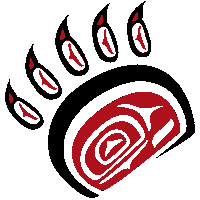
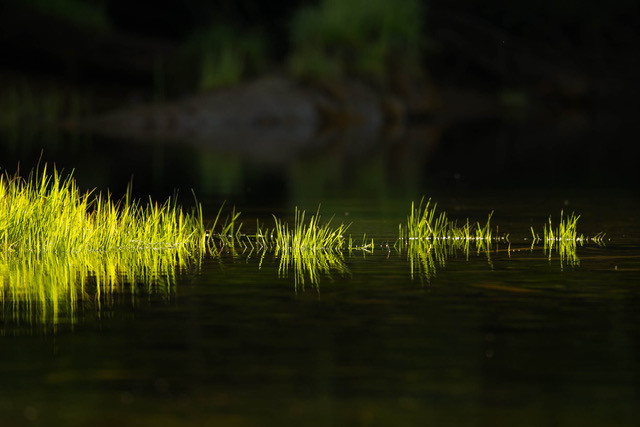
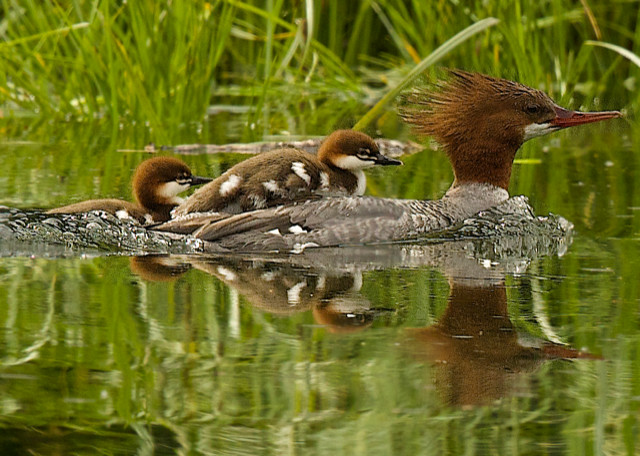
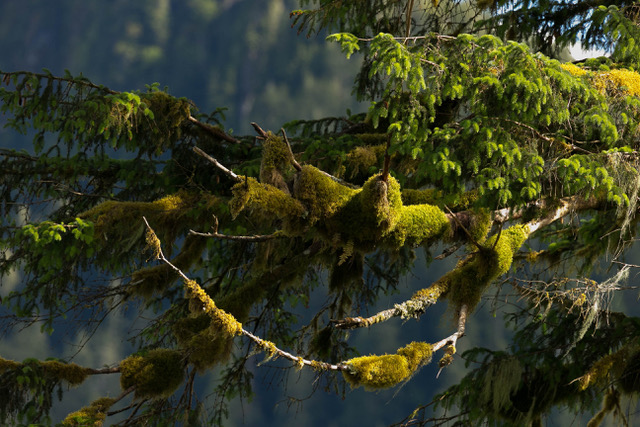
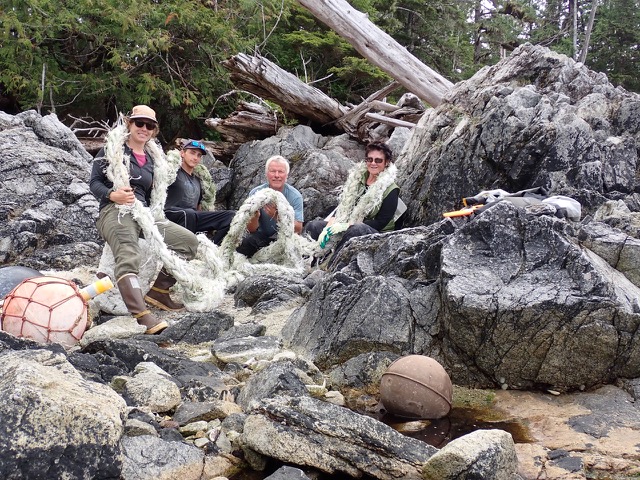
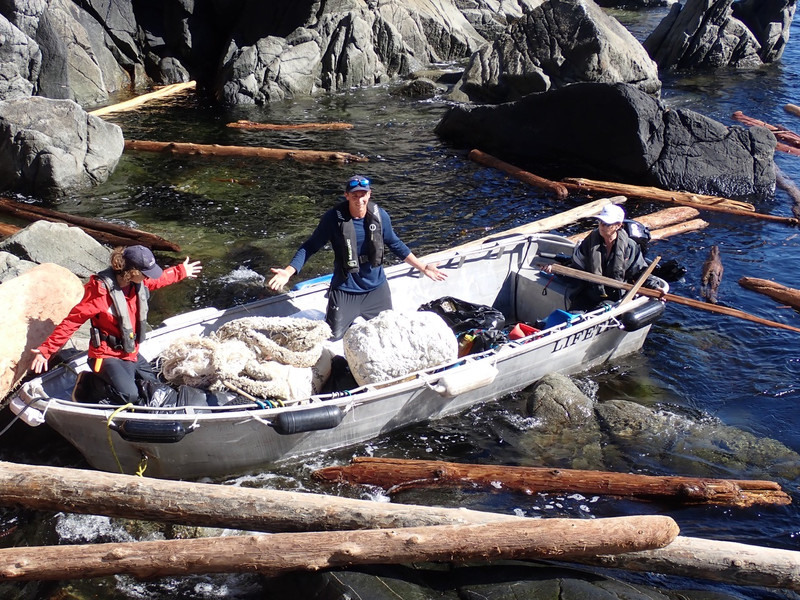 Ocean Adventures Charter Co., along with our fellow members of the Small Ships Tour Operators Association of BC, are proud to announce the Marine Debris Removal Initiative, currently taking place along 1000 kilometers of rugged shorelines on the central coast of British Columbia, (the outer islands at the edge of the Great Bear Rainforest.)
Ocean Adventures Charter Co., along with our fellow members of the Small Ships Tour Operators Association of BC, are proud to announce the Marine Debris Removal Initiative, currently taking place along 1000 kilometers of rugged shorelines on the central coast of British Columbia, (the outer islands at the edge of the Great Bear Rainforest.)
